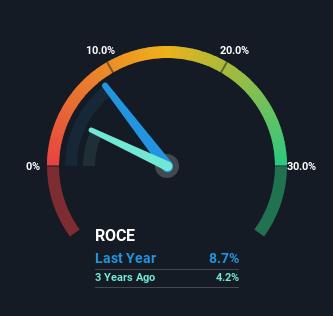Stock Analysis
- India
- /
- Electrical
- /
- NSEI:BBL
There's Been No Shortage Of Growth Recently For Bharat Bijlee's (NSE:BBL) Returns On Capital

Did you know there are some financial metrics that can provide clues of a potential multi-bagger? In a perfect world, we'd like to see a company investing more capital into its business and ideally the returns earned from that capital are also increasing. Basically this means that a company has profitable initiatives that it can continue to reinvest in, which is a trait of a compounding machine. So on that note, Bharat Bijlee (NSE:BBL) looks quite promising in regards to its trends of return on capital.
Return On Capital Employed (ROCE): What Is It?
For those who don't know, ROCE is a measure of a company's yearly pre-tax profit (its return), relative to the capital employed in the business. Analysts use this formula to calculate it for Bharat Bijlee:
Return on Capital Employed = Earnings Before Interest and Tax (EBIT) ÷ (Total Assets - Current Liabilities)
0.087 = ₹1.4b ÷ (₹21b - ₹5.9b) (Based on the trailing twelve months to December 2023).
Thus, Bharat Bijlee has an ROCE of 8.7%. In absolute terms, that's a low return and it also under-performs the Electrical industry average of 18%.
See our latest analysis for Bharat Bijlee

While the past is not representative of the future, it can be helpful to know how a company has performed historically, which is why we have this chart above. If you're interested in investigating Bharat Bijlee's past further, check out this free graph of past earnings, revenue and cash flow.
The Trend Of ROCE
We're glad to see that ROCE is heading in the right direction, even if it is still low at the moment. The numbers show that in the last five years, the returns generated on capital employed have grown considerably to 8.7%. The company is effectively making more money per dollar of capital used, and it's worth noting that the amount of capital has increased too, by 128%. The increasing returns on a growing amount of capital is common amongst multi-baggers and that's why we're impressed.
On a related note, the company's ratio of current liabilities to total assets has decreased to 28%, which basically reduces it's funding from the likes of short-term creditors or suppliers. So shareholders would be pleased that the growth in returns has mostly come from underlying business performance.
In Conclusion...
A company that is growing its returns on capital and can consistently reinvest in itself is a highly sought after trait, and that's what Bharat Bijlee has. And a remarkable 423% total return over the last five years tells us that investors are expecting more good things to come in the future. So given the stock has proven it has promising trends, it's worth researching the company further to see if these trends are likely to persist.
Bharat Bijlee does have some risks though, and we've spotted 2 warning signs for Bharat Bijlee that you might be interested in.
While Bharat Bijlee may not currently earn the highest returns, we've compiled a list of companies that currently earn more than 25% return on equity. Check out this free list here.
Valuation is complex, but we're helping make it simple.
Find out whether Bharat Bijlee is potentially over or undervalued by checking out our comprehensive analysis, which includes fair value estimates, risks and warnings, dividends, insider transactions and financial health.
View the Free AnalysisHave feedback on this article? Concerned about the content? Get in touch with us directly. Alternatively, email editorial-team (at) simplywallst.com.
This article by Simply Wall St is general in nature. We provide commentary based on historical data and analyst forecasts only using an unbiased methodology and our articles are not intended to be financial advice. It does not constitute a recommendation to buy or sell any stock, and does not take account of your objectives, or your financial situation. We aim to bring you long-term focused analysis driven by fundamental data. Note that our analysis may not factor in the latest price-sensitive company announcements or qualitative material. Simply Wall St has no position in any stocks mentioned.
About NSEI:BBL
Bharat Bijlee
Bharat Bijlee Limited operates as an electrical engineering company in India and internationally.
Flawless balance sheet with solid track record and pays a dividend.

